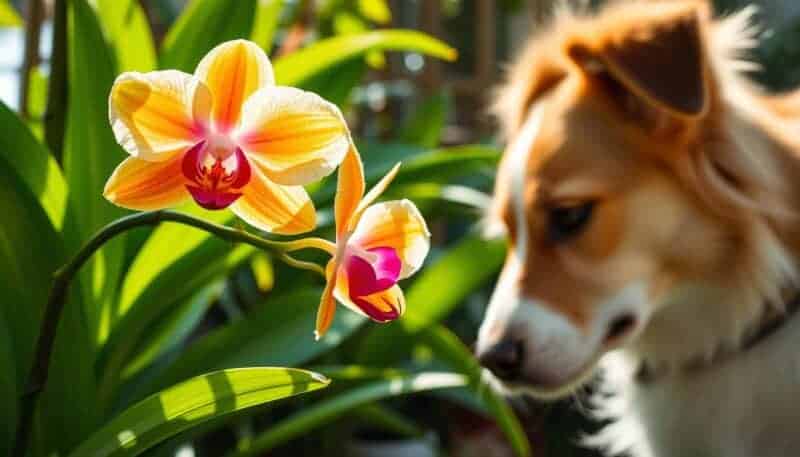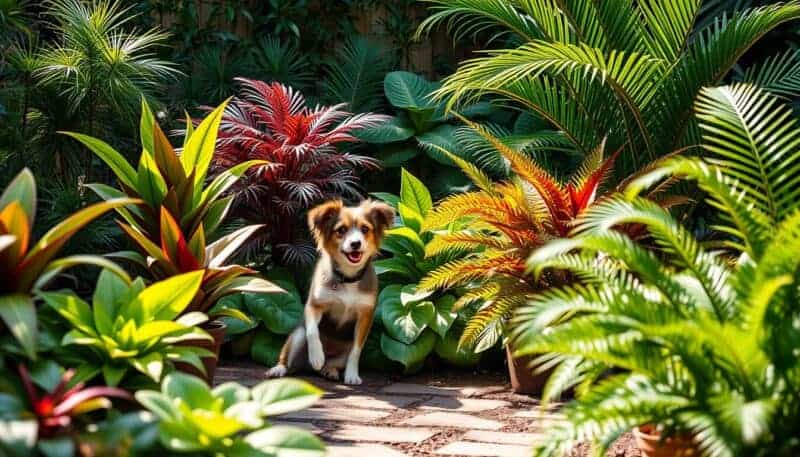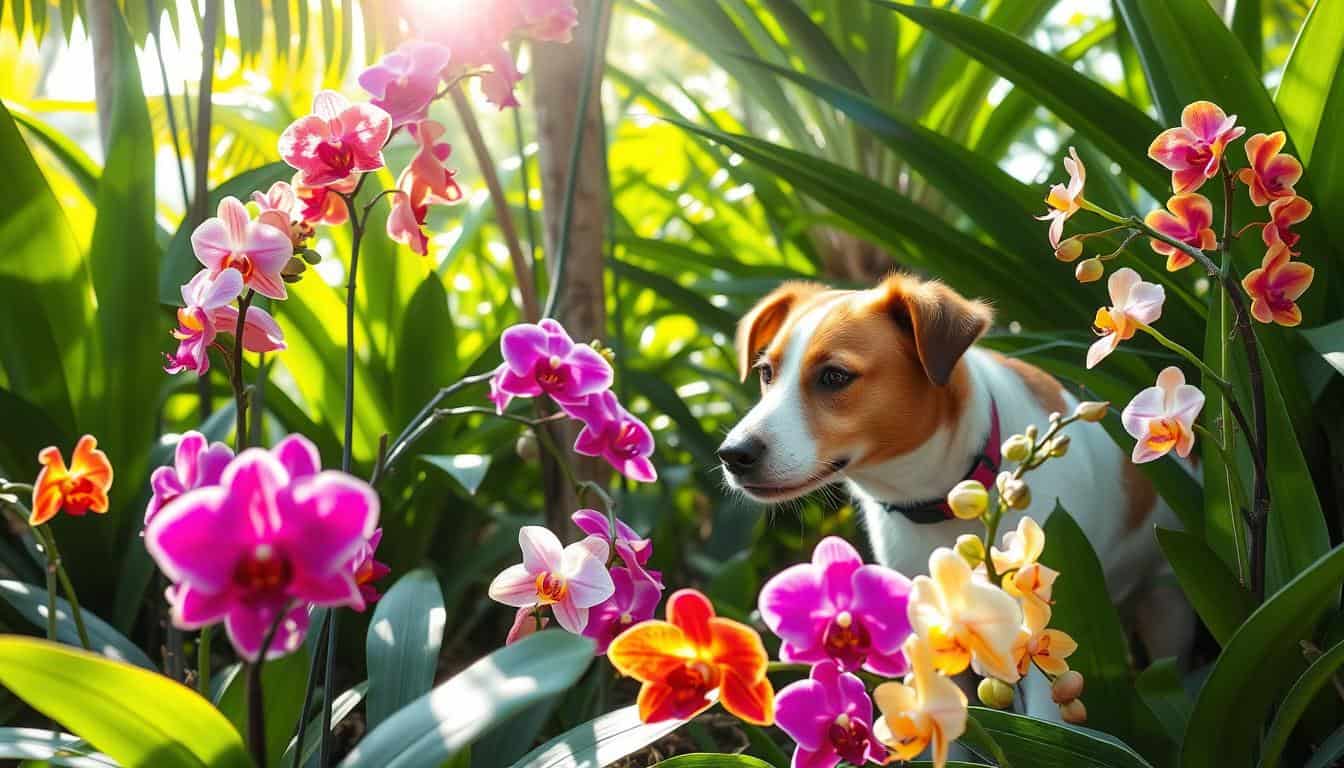Introduction
As a proud pet parent, your dog’s health is your biggest concern. With many beautiful houseplants around, you might wonder if orchids are safe for your dog. Today, we’ll find out the answers you’ve been looking for.
Orchids are loved for their beauty, but they might worry you if you have a dog. Let’s look into the risks and myths about orchids and dogs. We’ll uncover the truth about orchid toxicity and your furry friend.
We’ll explore orchid safety together, so you can protect your dog. The bond between a dog and their human is special. We must make sure our dogs are safe all the time.
- Understanding Orchid Safety for Your Canine Companion
- Are Orchids Poisonous to Dogs: The Definitive Answer
- Symptoms to Watch for After Dog-Orchid Contact
- The Science Behind Orchid Plant Components
- Safe vs. Dangerous Parts of Orchid Plants
- Prevention Tips for Pet Parents
- What to Do If Your Dog Eats an Orchid
- Safe Alternatives to Orchids for Dog Owners
- Creating a Pet-Safe Indoor Garden
- Common Misconceptions About Orchids and Pet Safety
- FAQ:
- What happens if a dog eats an orchid?
- Can you have orchids with dogs?
- Is orchid food toxic to dogs?
- How poisonous are orchids?
- What can I give my dog if he ate a poisonous plant?
- Is snake plant toxic to dogs?
- Is orchid scent safe for dogs?
- What parts of the orchid plant are the most dangerous for dogs?
- What symptoms should I watch for if my dog interacts with an orchid?
- Are there any safe alternatives to orchids for dog owners?
- How can I create a dog-safe indoor garden with orchids?
Understanding Orchid Safety for Your Canine Companion
Having an orchid at home can be tricky if you have a dog. It’s important to know the risks and safety tips for these beautiful plants. Let’s explore the different types of orchids, their parts, and how they might affect your dog.
Common Orchid Varieties in Households
Orchids come in many varieties, with hundreds found in homes across the U.S. Popular ones include the Phalaenopsis (Moth Orchid), Dendrobium, and Cattleya. These plants are loved for their bright colors, unique shapes, and long-lasting blooms.
Basic Orchid Plant Components
Orchids have several key parts. The leaves and stems give the plant structure. The flowers are the main attraction. And the roots help the plant get nutrients and stay anchored.
Natural Defense Mechanisms of Orchids
Orchids have natural ways to protect themselves, like dogs might. These defenses can be chemicals or physical barriers. Knowing about these defenses helps keep your dog safe around orchids.
It’s key to know about orchids and dogs to keep them both safe. By learning about the different types, parts, and defenses, you can create a safe space for your dog and enjoy your orchids too.
Are Orchids Poisonous to Dogs: The Definitive Answer
Many pet owners worry about the safety of their dogs around plants. They often ask, “Are orchids poisonous to dogs?” The answer is not simple.
Orchids are not usually a big danger to dogs. Some orchids might be mildly toxic if eaten, but serious harm is rare. Still, it’s good to know the risks and keep your dog safe.
Orchid Toxicity and Dogs
The danger from orchids depends on the type and what part is eaten. For example, the Phalaenopsis orchid can cause mild stomach problems if a dog eats a lot.
- Symptoms might include drooling, vomiting, or stomach upset.
- But these problems usually go away by themselves without needing a vet.
Orchids are not very toxic, and a dog would have to eat a lot to get sick. Dogs might feel bad from eating something they can’t digest, not from a poison.
“While orchids may not be the most dangerous plants for dogs, it’s still best to keep them out of reach to prevent any potential issues.”
Knowing orchids are only mildly toxic helps. By keeping your dog away from them, you can still enjoy the flowers safely.
| Orchid Variety | Toxicity Level | Potential Symptoms |
|---|---|---|
| Phalaenopsis (Moth Orchid) | Mild | Drooling, vomiting, digestive upset |
| Dendrobium | Mild | Mild gastrointestinal irritation |
| Oncidium (Dancing Lady Orchid) | Mild | Skin irritation, mild digestive issues |
Knowing how toxic different orchids are helps. With the right precautions, you can enjoy these plants while keeping your dog safe and healthy.
Symptoms to Watch for After Dog-Orchid Contact
As pet owners, knowing the risks of orchids and dogs is key. These flowers may look safe, but they can be dangerous if dogs eat them. Knowing the symptoms helps you act fast and get vet help if needed.
Digestive System Reactions
Orchids can upset a dog’s stomach. Look out for vomiting, diarrhea, and not wanting to eat. These signs mean your dog might have eaten the plant. They can lead to dehydration and need vet care quickly.
Behavioral Changes to Monitor
Watch your dog’s behavior after they might have touched orchids. Signs like being very tired, drooling, or moving strangely are bad. Also, if your dog acts differently or gets upset easily, it’s a warning sign.
Emergency Warning Signs
- Difficulty breathing or labored respiration
- Seizures or tremors
- Collapse or unconsciousness
- Severe abdominal pain or distension
If your dog shows any of these signs, get vet help right away. Quick action can save your dog’s life.
Being alert and knowing orchid symptoms keeps your dog safe. Protecting your pet from dog poison prevention and pet toxicology is crucial. It helps avoid the dangers of hazardous indoor plants.
The Science Behind Orchid Plant Components
Understanding orchid plants is key to knowing their impact on dogs. Orchids have unique flowers that attract us but might be toxic to pets. It’s important to know this.
Orchids contain chemicals that can harm dogs if eaten. These include alkaloids, glycosides, and other compounds. They help protect the plant but can be dangerous for dogs.
- Alkaloids: These compounds can affect animals in different ways, like making them feel high or sleepy.
- Glycosides: These molecules can break down into sugars and other substances. Some can be toxic to dogs if they eat too much.
- Secondary metabolites: Orchids make many of these compounds to keep pests away. But, they can also be harmful to dogs.
Knowing about these chemicals helps us understand if orchids are safe for dogs. By learning about the chemicals in different orchids, we can keep our pets safe.

“The best way to protect your dog from the potential dangers of orchids is to educate yourself on the science behind these plants.”
Being informed and careful is the best way to keep your home safe for both your orchids and dogs.
Safe vs. Dangerous Parts of Orchid Plants
Knowing which parts of orchid plants are safe for dogs is key. While most orchids aren’t toxic, some parts can still be harmful. Let’s look at the safety levels of different orchid parts.
Leaves and Stems
Most orchid leaves and stems are safe for dogs. They usually have low toxins and won’t hurt your pet much. But, it’s good to stop your dog from chewing on them to avoid stomach problems.
Flowers and Roots
Orchid flowers and roots are more risky for dogs. The flowers might upset your dog’s stomach if eaten. Some roots also have toxins that could make your dog very sick.
Potting Media Considerations
Think about the soil your orchids are in too. Some soils, like sphagnum moss or bark, can harm dogs if eaten. They might cause stomach problems or blockages.
To keep your dog safe, know which orchid parts are safe. This way, you can make your home safe for your pet. The best rule is to keep all orchids out of your dog’s reach.
Prevention Tips for Pet Parents
As a responsible pet owner, keeping your four-legged friend safe is crucial. To prevent your dog from getting close to toxic orchids, a few simple steps can help. Let’s look at some ways to make your home a pet-friendly blooms space.
- Put orchids where your dog can’t reach them. Use high shelves, closed terrariums, or spots your pup can’t get to.
- Choose strong, dog-proof containers for your orchids. Make sure pots and planters are secure to stop curious noses and paws.
- Add dog-safe plants to your decor with orchids. This can distract your dog from the dog poison prevention plants.
- Train your dog to avoid certain plants. Use positive rewards for ignoring or moving away from orchids.
- Check your home and garden often for fallen orchid parts that could be dangerous to your pet.
By following these tips, you can make a safer space for your pet and orchids. Taking proactive steps towards dog poison prevention will help you relax and keep your dog safe.

“The safety of our pets is our primary concern, and with a little planning, we can enjoy the beauty of orchids while keeping our canine companions out of harm’s way.”
What to Do If Your Dog Eats an Orchid
Seeing your dog eat an orchid can worry you. But, with the right steps, you can keep them safe. We’ll show you what to do first, when to call the vet, and the treatment options.
Immediate Action Steps
If your dog eats an orchid, take the plant away from them. Try to get them to spit out any plant bits with water or bread. This can help get rid of the bad stuff.
When to Contact Your Veterinarian
Even if your dog seems fine, call your vet. Pet toxicology experts can tell you what to do next. Tell them about the orchid, how much your dog ate, and any signs they show.
Treatment Options
Your vet might suggest a few things, like:
- Induced vomiting to get rid of more plant bits
- Activated charcoal to soak up toxins
- Supportive care, like fluids or meds, for symptoms
- Watching your dog closely for any changes
Act fast and get vet help for hazardous indoor plants like orchids. These steps can keep your dog safe and healthy.
Safe Alternatives to Orchids for Dog Owners
As pet owners, we always put our furry friends first. Orchids are beautiful, but they can be harmful to dogs. Luckily, there are many dog-safe plants and pet-friendly blooms that are great alternatives.
The African Violet is a vibrant, easy-to-care-for plant safe for dogs. The Peperomia plant, with its varied leaves, is also a good choice. Succulents like Jade Plants and Echeveria are safe and can handle a little nibble from a dog.
If you want plants that bloom, try the African Daisy or Gerbera Daisy. They’re pet-friendly and can brighten up your home. Herbs like Catnip, Basil, and Parsley are safe for dogs and can even keep them happy and busy.
| Dog-Safe Plant | Common Name | Toxicity Level |
|---|---|---|
| Peperomia | Baby Rubber Plant | Non-toxic |
| Jade Plant | Money Plant | Non-toxic |
| Gerbera Daisy | Barberton Daisy | Non-toxic |
| Basil | Sweet Basil | Non-toxic |
Adding these dog-safe plants and pet-friendly blooms to your home makes it safe for both you and your dog. It’s important to pick plants that are safe for your pet. So, you can take pleasure in the gorgeous garden without having to worry about your dog’s safety.
“Creating a safe and enjoyable living space for both you and your pet is a top priority. By choosing the right plants, you can ensure your dog’s well-being while still enjoying the beauty of nature indoors.”
Creating a Pet-Safe Indoor Garden
As a pet parent, making your indoor garden safe for your dog is key. Choose dog-safe plants and arrange them wisely. This way, you can have a beautiful, pet-friendly space at home. Here are some tips to make your indoor garden safe and lovely for both your plants and pet.
Choosing the Right Plants
Some plants are safer for pets than others. Stay away from hazardous indoor plants like lilies and sago palms. They can harm your dog. Instead, pick safe plants like African violets and spider plants. Always check with your vet before choosing new plants.
Arrangement and Placement
Where you place your plants matters a lot. Put dog-safe plants where your dog can’t reach them. Use high shelves or pet barriers. Also, think about using terrariums or hanging planters to keep plants safe.
Maintenance and Monitoring
Keeping your garden clean and watching your dog around plants is important. Clean up any dropped leaves or soil quickly. Watch your dog for any signs of trouble from plants.
Follow these tips to make a safe, beautiful indoor garden. With some planning and care, you can have a happy space for your dog-safe plants and pet. Enjoy your harmonious home together.
Common Misconceptions About Orchids and Pet Safety
It’s important to know the truth about keeping your dog safe. Not all orchids are dangerous to dogs. Let’s clear up some myths and look at the science behind orchid toxicity.
Debunking Popular Myths
Many think all orchids are bad for dogs, but that’s not true. Some orchids can be harmful, but many are safe. Knowing which orchids are safe is key.
Scientific Evidence
Research shows that orchid toxicity varies by type and chemical content. Some orchids have compounds that can upset a dog’s stomach or cause skin issues. But, how a dog reacts depends on the amount eaten and their sensitivity.
Learning about orchids and their differences helps you keep your dog safe. You can enjoy these beautiful flowers without worry.
FAQ:
What happens if a dog eats an orchid?
If a dog eats an orchidis, the effects are typically mild, such as minor stomach upset or vomiting. Orchids are generally considered non-toxic to dogs. However, monitor your pet for unusual symptoms and provide water to soothe irritation. If issues persist, consult your veterinarian for guidance to ensure your dog’s safety.
Can you have orchids with dogs?
Yes, you can have orchidis with dogs as most orchid species are non-toxic to pets. However, ensure your dog doesn’t chew on the leaves or flowers, as ingestion may cause mild stomach upset. Place orchids in elevated spots to avoid accidental damage and maintain a safe, harmonious environment for both plants and pets.
Is orchid food toxic to dogs?
Orchid food, including fertilizers designed for orchidis, may be toxic to dogs if ingested. These products often contain chemicals harmful to pets, causing symptoms like vomiting, diarrhea, or more severe reactions. Keep all plant fertilizers out of reach, and seek veterinary assistance immediately if your dog shows signs of poisoning. Prevention is key to safety.
How poisonous are orchids?
Orchid plants, including orchidis, are generally not considered poisonous to pets or humans. However, some varieties may cause mild stomach upset if ingested in large quantities. Always ensure pets have safe access to non-toxic plants. Consult a veterinarian if your pet shows any unusual symptoms after contact with or consumption of plants.
What can I give my dog if he ate a poisonous plant?
If your dog ingests a poisonous plant, act quickly. Induce vomiting only if instructed by a vet. Activated charcoal can help absorb toxins. Hydrate your pet and monitor for symptoms. While orchidis isn’t toxic, always verify plant safety before exposure. Immediate veterinary attention is critical for proper diagnosis and treatment.
Is snake plant toxic to dogs?
The snake plant, though popular for its aesthetic appeal, is toxic to dogs if ingested. Its saponins can cause nausea, vomiting, and drooling. While unrelated to orchidis, this plant requires careful placement in homes with pets. Keep it out of reach to ensure your dog’s safety and prevent accidental poisoning.
Is orchid scent safe for dogs?
The delicate fragrance of orchidis is generally safe for dogs when encountered naturally. However, synthetic orchid scents or oils might contain additives harmful to pets. Always ensure your dog’s exposure to orchidis is limited to natural sources, avoiding artificial products to prevent allergic reactions or respiratory sensitivities. Supervision is key for safety.
What parts of the orchid plant are the most dangerous for dogs?
The leaves and stems have the most toxic compounds. These can cause stomach issues in dogs. Flowers and roots have less, but still keep them away.
What symptoms should I watch for if my dog interacts with an orchid?
Watch for vomiting, diarrhea, lethargy, and loss of appetite. If your dog shows these signs, call your vet right away.
Are there any safe alternatives to orchids for dog owners?
Yes! Safe options include African violets, begonias, and succulents. They are non-toxic and can beautify your home without risk to your dog.
How can I create a dog-safe indoor garden with orchids?
Place orchids where your dog can’t reach, like high shelves or closed cabinets. Use pet gates or enclosed stands to keep your dog away.
Share your thoughts in the comments below! If you enjoyed this post, consider subscribing to our newsletter for more pet tips, stories and blogs!

